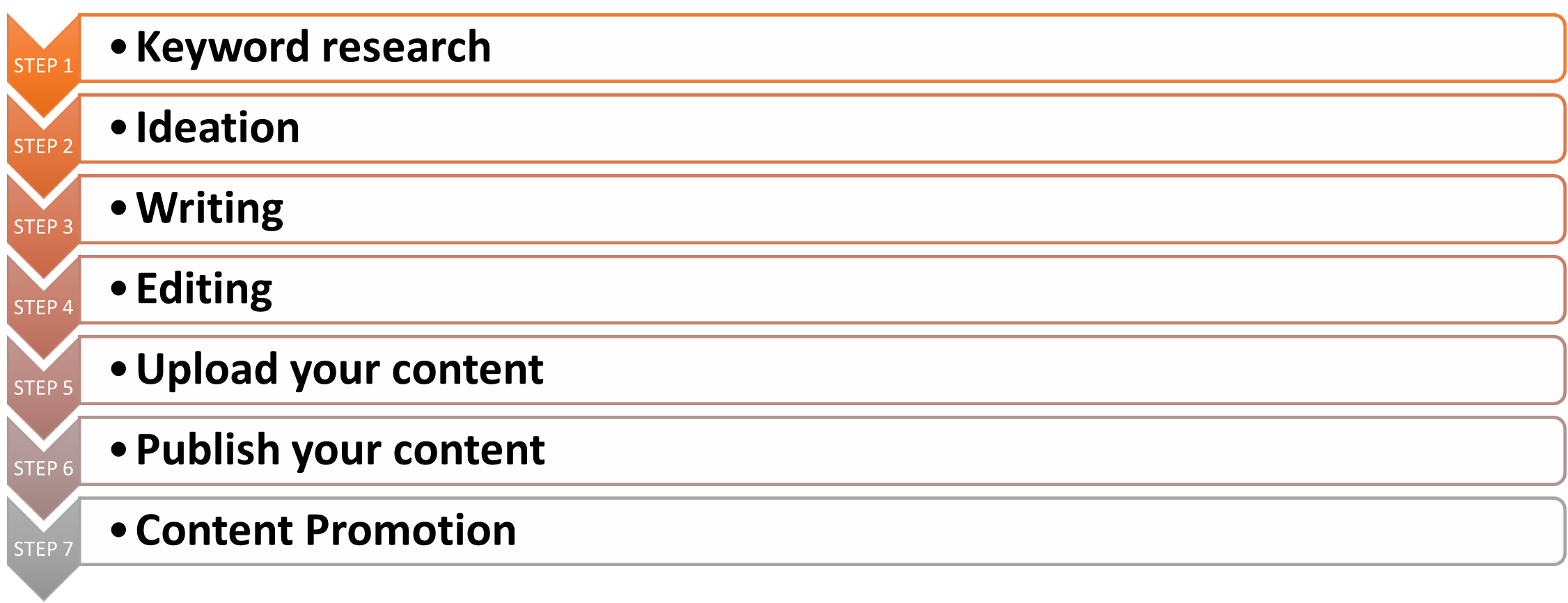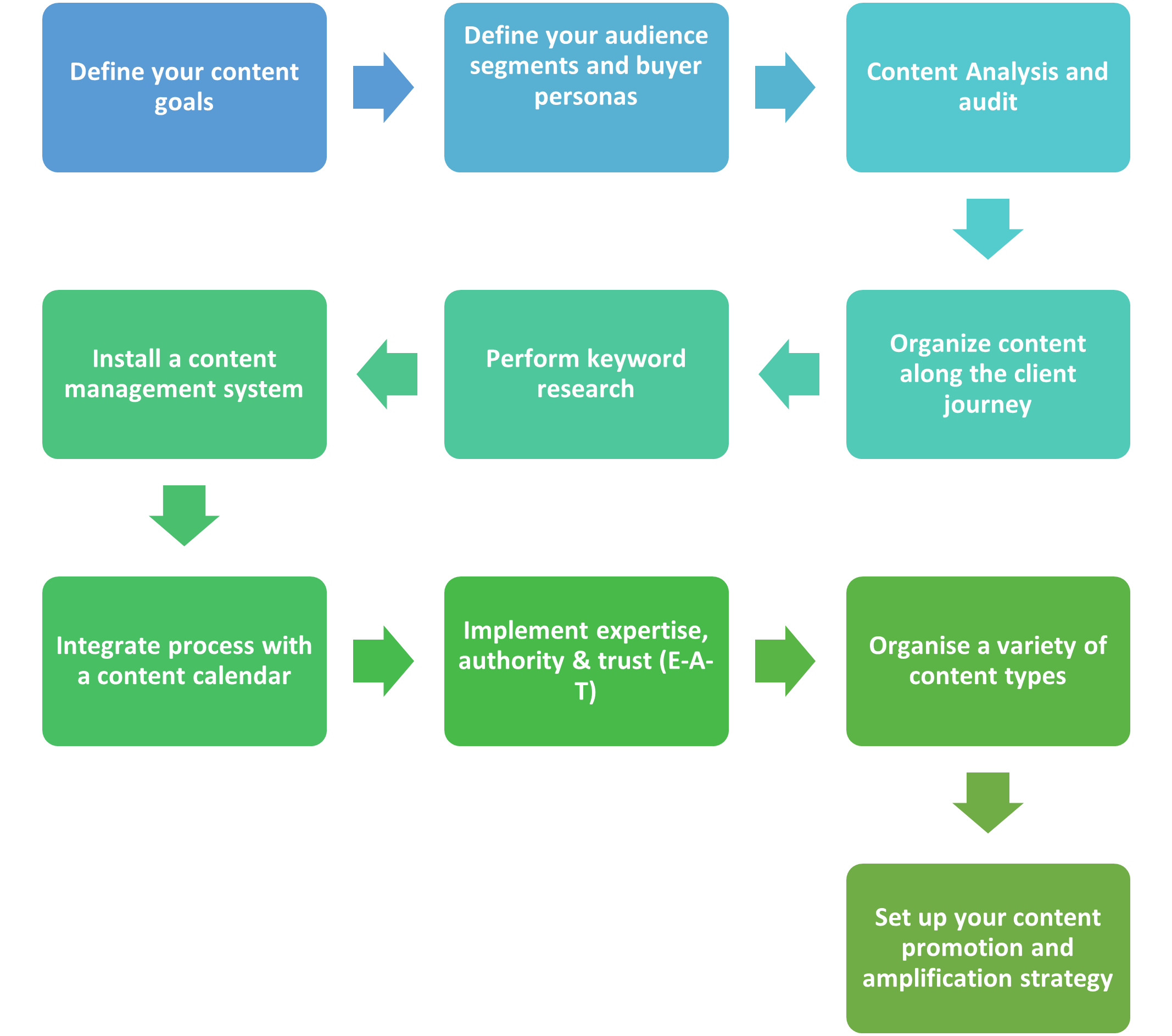Today’s digital marketing encompasses almost every facet of a company’s interaction. Businesses create content strategies across all online channels to grab the attention of an increasingly tech-savvy audience. The backbone of any digital marketing plan is content. It provides value to a website by giving visitors a reason to visit the site. Websites, blogging, and social media advertising are all examples of digital marketing, and any form of textual, visual, video or interactive component that is embedded in the webspace is the content. Content marketing generates 3X the number of leads as traditional marketing while costing 62% less.
What is Content Creation?
Content creation is the process of identifying a relevant topic to write about, designing the wireframe model, formalizing the strategy (keyword or otherwise), aligning all this with a content calendar, and then actually creating the content. Content marketers generate 126 percent more leads than those that don’t. Surveys reveal that a customer reading a blog is responsible for 61% of all internet sales.
Why it’s important in this digital era?
The purpose of digital content is to generate inclination and engagement for whatever the brand desires—typically more sales—by creating a plan that covers many platforms and connects viewers to relevant content.
Digital content needs to be interlinked and engaging in such a way that a Facebook post can link the visitor to a podcast or a blog post that drives traffic to lead-generating whitepapers. Content creation services build and implement strategies to make their content interacts with the array of the platform.
Conversion-oriented content engages audiences and motivates them to act. Visitors become leads, leads become customers, and customers become followers. As you can expect, good content marketing requires strong conversion-oriented writing.
According to a Clutch study, more than 80% of individuals purchase a product or service as a result of watching business content.
Two-thirds of individuals (67%) think content marketing is beneficial and valuable, compared to 33% who think it is biased and unreliable.
The goal of content marketing is to move consumers through the sales funnel of a company. More than half of individuals (53%) are more inclined to revisit a company’s website after viewing content marketing, and 50% are more likely to explore the company’s products after viewing content marketing.
Excellent content is a valuable asset. It has the power to create good experiences for potential customers and entice them to revisit. It’s the passport to attracting the attention of the target audience and maintaining a strong brand image.
Webinars, autoresponders, and surveys are all examples of marketing campaigns and each of them has its method. Follow these steps to develop content and swiftly improve your conversion rate.
Step1. Keyword research
SEO research reveals the search volume of a given keyword phrase and whether it’s worth the time and effort to create content for it. It’s probable that creating your buyer persona provided you with some ideas for what to write about and what questions your audience might have, which is a great idea to initiate. Another aspect is domain authority which is an important component in search engine optimization. The number of external sites that link back to your content gives you domain authority. To accomplish this, you’ll need a sizable library of information that is valuable enough to be cited.
Also, use tools like SEMrush or Moz Keyword Explorer to find keywords. Look for the related searches section on search engine results pages (SERPs).
Step 2. Ideation
Content production necessitates creativity. If you’re stuck for ideas, look for inspiration in books you’ve read, industry research, your competitors’ websites, or related searches on Google SERPs.
The process of researching and selecting the most core concepts that would captivate your target audience is known as content ideation in content marketing. The term ‘engaging,’ when applied to content implies that content is fascinating, entertaining, or informative, as well as shareable.
AnswerThePublic, for example, can help you generate questions that your target audience might be looking for. To get started, simply type your keyword into the search box. AnswerThePublic then generates a series of questions and proposes some potential topics based on that term.
Step 3. Writing
This aspect of content development could be defined as being unique. To engage your audience to read your content, use titles, meta descriptions, and other teasers. Make the benefit of your material clear in the title to convince readers to read it. Make something special. Don’t just rehash what’s already out there. To highlight your views, utilize a unique style or quote new research.
Step 4. Editing
Editing the work is a very subjective experience. The editor may be concerned with grammar or expecting a more casual tone. In any case, there are a few things to keep an eye out for as you polish your material, such as active voice, clear language, short sentences, and lots of whitespaces. Grammarly and Duplichecker are two applications that can help you cut down on your editing time.
Step 5. Upload your content
Create a directory and achieve your creations. A CMS provides the benefit of linking and keeping all of your content under one roof. As a result, you can send an email with a link to a landing page or a content offer. You may also assess the results of all the content you developed for a certain campaign (which can help with content audits). You can avoid having a disconnected content marketing system by using a CMS.
A content management system (CMS) is software that stores and displays digital material on your website (or anywhere else on the web).CMS Hub, for example, is home to our blog, where you can find all of our amazing material as well as handy freebies.
Step 6. Publish your content
Immediately pressing the publish button offers a significant influence on your readership. However, if you commit to a regular posting schedule, such as a new post every Wednesday, your audience will anticipate seeing new posts on Wednesdays. You can publish your content immediately after uploading it, or you can wait for the best time to do so.
Another thing to remember is to publish in response to trends or time-sensitive occurrences. If you’re creating content about national holidays or current events, for example, you’ll want to publish it at specified times.
Step 7. Content Promotion
Finally, it’s time to spread the word about your work. This can be accomplished through a variety of channels, including social media, email marketing, and pay-per-click advertising. Consider which outlets your target audience uses to promote your content. It’s critical to meet your audience where they are and promote your content on that platform, wherever that may be such as Facebook, Instagram, or YouTube. Collaboration with influencers or other brands can also help you promote your content and reach a larger audience.
To make your content work for you content creation agencies and marketers must build a strong content strategy.
A content strategy is an all-encompassing approach to creating content that supports significant business objectives. Content strategy refers to the higher-level planning process. Content marketing, on the other hand, is the actual process of developing, publishing, and promoting content.
Define your content goals: Establishing defined content goals and KPIs is critical. You can’t establish a strategy, monitor program outcomes, or communicate ROI to company stakeholders in absence of defined goals.
Define your audience segments and buyer personas: Create personas based on your audience research. This stage is crucial because a content strategy that does not target its audience is indefinite and is a waste.
Content Analysis and audit: Conduct a competitive analysis to develop a powerful and distinct content strategy. Knowing who your customers are isn’t enough when it comes to reviewing and evaluating your content.
Organize content along the client journey: Trace each persona’s customer journey along the sales funnel. It is a natural human tendency to seek answers to specific questions. So, all the way through the conversion funnel, you must endeavor to address your audience’s pressing questions.
Conduct keyword research: You need traffic whether your primary goal is lead generation or increasing eCommerce sales. However, strong content alone will not bring thousands of people to your site. You should also optimize for keywords.
Install a content management system: Your CMS allows you to create, organize, publish, and store various kinds of content, including blog posts, audio, video, PDFs, etc.
Integrate process with a content calendar: Set up a process including project management software, grammar checking software, SEO software, and other tools in addition to your CMS. After that, create a content calendar. It’s an organizational framework that connects your content team to your overall marketing strategy and objectives.
Implement expertise, authority & trust (E-A-T): Conversions, consumer loyalty, SEO, and other factors are all influenced by brand trust. That’s why exhibiting your brand’s natural knowledge throughout your content strategy is crucial for building trust. If your company sells software, you should stick to software-related themes rather than Networking or IT infrastructure.
Organize a variety of content types: In your content strategy, try to mix up the sorts of content marketing. Because various demographics consume media in different ways. Some people prefer visual content, some prefer auditory stuff, and yet others prefer to read text.
Set up your content promotion and amplification strategy: The process does not stop at publishing. You must incorporate amplification into your content strategy. Share your posts on different social media networks. Content marketing is used by 86 percent of firms to raise brand awareness, while 79 percent say it helps them educate their customers and 75 percent say it helps them build credibility and trust. More than half of respondents think content marketing helps them generate sales and revenue.
Planning, drafting, editing, and productivity are the four core areas in which the recommended content writing tools are arranged.
Content production tools are constantly being developed and introduced, and many of them can be invaluable in the content marketing process.
Whether you need assistance with presentations, podcasts, webinars, social media postings, making infographics, managing email marketing, or adopting chatbots, there is a tool to help you get more done.
Refer to https://www.techfunnel.com/martech/best-content-creation-tools/ for detailed insight on content creation tools. 32 valuable tools can help you better fulfill your responsibility as a blogger, content marketer, or content provider. To assist you to offer the best editorials, videos, and infographics to your audience, choose the best fit from different content creation tools with a defined purpose.
Every roadmap has speed breakers. Here are the obstacles that must be overcome to put the content generation process on autopilot:
We all know that providing content for blogs, websites, social media, and downloadable information is crucial, whether you’re a B2B or B2C company. That’s why it’s critical to backtrack and consider some of the roadblocks that could derail the process and how we may overcome them.
Figure 1 Obstacles that lead to the downfall of the audience
Monotonous Tone
It’s not the ideal way to keep doing what you’ve done before (with the same structure and topics since you think it worked before and would work again). It’s one of the key reasons why there’s so much duplicate content out there that eventually loses its audience’s attention.
Solution
Do not be afraid to experiment with new ways and styles before your competition. To get insight and generate ideas for future blog entries for your firm, read and share content from industry leaders. Reading high-quality content regularly will help you create your own.
Imbalanced Creativity and SEO
It’s always important to keep search engine optimization in mind while producing blogs or website content for your site (SEO). However, striking the correct mix between creativity and SEO can be tough. Stuffing keywords between the lines isn’t always the best answer; it can make the phrase sound unprofessional.
Solution
Another option for overcoming this problem is to use syndicated content. Producing syndicated content on other authority sites earns you a backlink, which boosts your website’s SEO authority.
Lack of Time management
Another aspect while creating content to keep under control is time. Although quality is better than quantity, exceeding the time beyond the limit to attain standard is unacceptable. One of the numerous issues that content creators encounter is a lack of resources, especially at agencies where you’re constantly juggling client deliverables and fitting in time for your content authoring. Companies frequently discover that there is insufficient funding to devote time to blogging instead of activities that are deemed to be more useful to the firm.
Solution
Delegating content topics to employees with specific skills enables better quality content delivery when a team of employees with various expertise is present.
Lack of Uniqueness
When writing on the same themes that have already been discussed in the market, companies are now facing a rising amount of competition, especially if they work in a tight segment.
Solution
Make sure that each piece of material you publish is the best it can be. Take the time to carefully select an engaging topic that will resonate with your audience.
Paid content vs Organic reach
There has been a significant trend toward paid marketing, with businesses paying for their content to appear in search results. To be honest, this is preventing unpaid content from being found in organic search results.
Solution
Define a sufficient budget and particular demographics for targeting your content to the correct people, set targets (increase online traffic, increase social media followers), and assess whether it is worthwhile. Experiment with a few different ways to determine what works best.
Final Thoughts
You learned that content is an essential part of your marketing strategy in this content creation process. Content marketing is less expensive, with content, such as a whitepaper, landing page, or online image, can be evergreen, and accessible to anybody with access to a search engine. It helps in increasing brand awareness and can provide consumers with high-quality content when they are ready and seeking it. This accessibility of information will soon become a well-known resource in your field. Expect your brand awareness to develop organically without the need to push others. Do the good work and let the world share it online.
Other Useful Resources:
What Exactly is Content Distribution?
Content Marketing Benefits and Its Challenges
Content Marketing Is It Still Effective?









